

File:John La Farge - The Wolf Charmer.jpg. File:The Wolf-Charmer MET DP821699.jpg. Category:Drawings of wolves. File:Petits Paysans surpris par un loup.jpg. File:Paul de Vos - The goat and the wolf cub.jpg. Category:Le Loup devenu berger. CancelEditDeletePreviewrevert Text of the note (may include Wiki markup) Could not save your note (edit conflict or other problem).
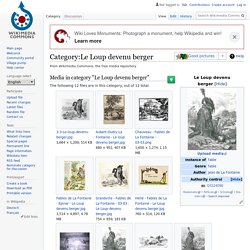
Please copy the text in the edit box below and insert it manually by editing this page. Upon submitting the note will be published multi-licensed under the terms of the CC-BY-SA-3.0 license and of the GFDL, versions 1.2, 1.3, or any later version. See our terms of use for more details. Add a noteDraw a rectangle onto the image above (press the left mouse button, then drag and release).This file has annotations. Category:Paintings of wolves. Loup dans la culture. Le loup est l'animal le plus emblématique de l'histoire de l'Eurasie, il était à l'honneur durant l'Antiquité chez la totalité des anciens peuples européens[1].
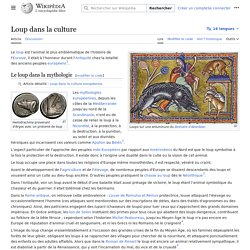
Le loup dans la mythologie[modifier | modifier le code] Hemidrachme provenant d'Argos avec un protomé de loup Les mythologies européennes, depuis les côtes de la Méditerranée jusqu'au nord de la Scandinavie, n'ont eu de cesse de relier le loup à la fécondité, à la protection, à la destruction, à la punition, au soleil et aux divinités héroïques qui incarnaient ces valeurs comme Apollon ou Belen[2].
L'aspect particulier de l'approche des peuples indo-Européens par rapport aux Amérindiens du Nord est que le loup symbolise à la fois la protection et la destruction. Il existe donc à l'origine une dualité dans le culte ou la vision de cet animal. Le loup occupe une place dans toutes les religions d'Europe même monothéistes, il est respecté, vénéré ou craint. Les loups dans le folklore[modifier | modifier le code] Loup dans la culture européenne. Le Loup gris, une sous-espèce de Canis lupus plus simplement appelé localement loup, est un des animaux les plus emblématiques d'Europe.
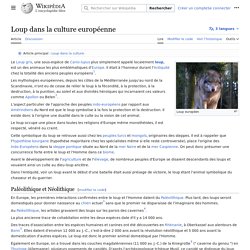
Il était à l'honneur durant l'Antiquité chez la totalité des anciens peuples européens[1]. Category:Werewolves. CancelEditDeletePreviewrevert Text of the note (may include Wiki markup) Could not save your note (edit conflict or other problem).
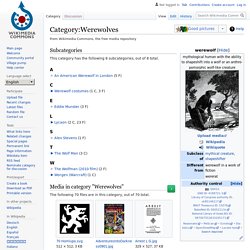
Please copy the text in the edit box below and insert it manually by editing this page. Upon submitting the note will be published multi-licensed under the terms of the CC-BY-SA-3.0 license and of the GFDL, versions 1.2, 1.3, or any later version. See our terms of use for more details. Add a noteDraw a rectangle onto the image above (press the left mouse button, then drag and release).This file has annotations. Category:Wolves in art — Wikimedia Commons. CancelEditDeletePreviewrevert Text of the note (may include Wiki markup) Could not save your note (edit conflict or other problem).
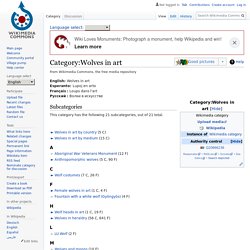
Please copy the text in the edit box below and insert it manually by editing this page. Upon submitting the note will be published multi-licensed under the terms of the CC-BY-SA-3.0 license and of the GFDL, versions 1.2, 1.3, or any later version. See our terms of use for more details. Add a noteDraw a rectangle onto the image above (press the left mouse button, then drag and release).This file has annotations. Save To modify annotations, your browser needs to have the XMLHttpRequest object.
Le Monde alpin et rhodanien. Revue régionale d'ethnologie, n°1-3/2002. Le fait du loup. De la peur à la passion : le renversement d'une image, sous la direction de Véronique Campion-Vincent, Jean-Claude Duclos et Christian Abry. Serge Reggiani - Les Loups sont entrés dans Paris. Will we ever know the difference between a wolf and a dog? Living in the Canadian Rockies allows me ample opportunities to get out into nature.
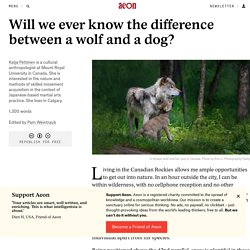
In an hour outside the city, I can be within wilderness, with no cellphone reception and no other humans. Such wilderness, of course, comes with plenty of wildlife, including a number of contemporary North American canids such as coyotes and wolves. While I tend to go without any human company, I do have a canid companion, one taxonomically positioned within the species Canis familiaris but also bearing a proper name, Yuni, which distinguishes him as a particular individual apart from his species. Being positioned above the 42nd parallel, snow is plentiful in these parts of the Rockies, often starting to fall early in the autumn. While Yuni and I get out plenty in the summer, enjoying the relative warmth of the area, we are both in our element during the winter. Being out in the wild during winter affords me, a human, with rich visual signs present in the landscape.
Updates on everything new at Aeon. Site officiel du musée du Louvre.
Cynégétique & Louveterie. Américains et Boréaux. Scandinaves / Germains. Histoire & Mythologie. Littérature & science obsolète.
MOYEN AGE - RENAISSANCE. Monde gréco-romain. EGYPTE. Turcs et Mongols.